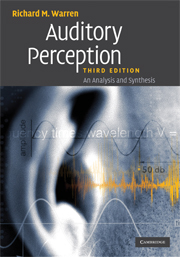Book contents
- Frontmatter
- Contents
- Preface
- 1 Sound and the auditory system
- 2 Spatial localization and binaural hearing
- 3 Perception of acoustic repetition: pitch and infrapitch
- 4 Judging auditory magnitudes: the sone scale of loudness and the mel scale of pitch
- 5 Perception of acoustic sequences
- 6 Perceptual restoration of missing sounds
- 7 Speech
- 8 The relation of hearing to perception in general
- References
- Index
1 - Sound and the auditory system
Published online by Cambridge University Press: 18 May 2010
- Frontmatter
- Contents
- Preface
- 1 Sound and the auditory system
- 2 Spatial localization and binaural hearing
- 3 Perception of acoustic repetition: pitch and infrapitch
- 4 Judging auditory magnitudes: the sone scale of loudness and the mel scale of pitch
- 5 Perception of acoustic sequences
- 6 Perceptual restoration of missing sounds
- 7 Speech
- 8 The relation of hearing to perception in general
- References
- Index
Summary
This chapter provides a brief introduction to the physical nature of sound, the manner in which it is transmitted and transformed within the ear, and the nature of auditory neural responses.
The nature of auditory stimuli
The sounds responsible for hearing consist of rapid changes in air pressure that can be produced in a variety of ways – for example, by vibrations of objects such as the tines of a tuning fork or the wings of an insect, by puffs of air released by a siren or our vocal cords, and by the noisy turbulence of air escaping from a small opening. Sound travels through the air at sea level at a velocity of about 335 meters per second, or 1,100 feet per second, for all but very great amplitudes (extent of pressure changes) and for all waveforms (patterns of pressure changes over time). Special interest is attached to periodic sounds, or sounds having a fixed waveform repeated at a fixed frequency. Frequency is measured in hertz (Hz), or numbers of repetitions of a waveform per second; thus, 1,000 Hz corresponds to 1,000 repetitions of a particular waveform per second. The time required for one complete statement of an iterated waveform is its period. Periodic sounds from about 20 through 16,000 Hz can produce a sensation of pitch and are called tones.
- Type
- Chapter
- Information
- Auditory PerceptionAn Analysis and Synthesis, pp. 1 - 34Publisher: Cambridge University PressPrint publication year: 2008



